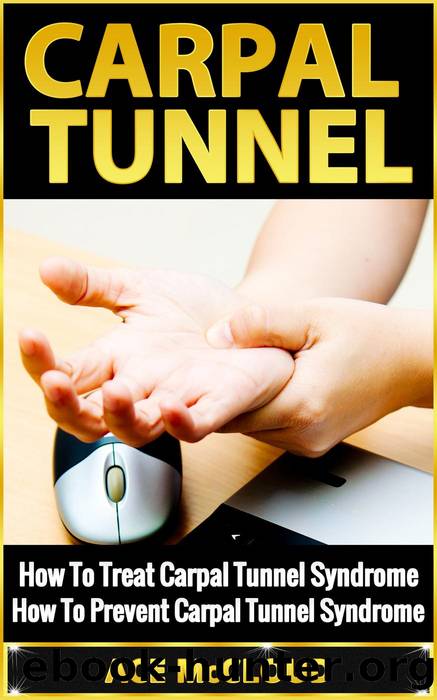Carpal Tunnel by Ace McCloud

Author:Ace McCloud
Language: eng
Format: epub
Tags: carpal tunnel, carpal tunnel syndrome book diet kindle, carpal tunnel treatment prevention guide tips anti inflammatory relief cure exercises, hand pain relief carpal wrist help treatment finger, repetitive stress injury strain relief treatments exercises pain relief, pain suffering cure hands control carpal foods kindle, health fitness physical ailments pain orthopedics Musculoskeletal
Publisher: Pro Mastery Publishing
Published: 2017-03-10T00:00:00+00:00
Chapter 4: How To Treat Carpal Tunnel Syndrome
As with any condition, moderate and conservative treatments should be tried first before turning to invasive surgical procedures. To help decrease the inflammation associated with carpal tunnel (and also the symptoms associated with it), consider taking anti-inflammatory medications, also known as NSAIDâs, such as Advil.
You can also wear a wrist brace or computer gloves to support the wrist area. In the neutral position (wrist level), the carpal tunnel will be at its widest diameter, exerting the least amount of pressure on the median nerve. Be sure to wear the brace or gloves while doing repetitive hand and finger activities, and possibly at night as well while sleeping if the symptoms are severe enough.
If symptoms persist, ask your physician about cortisone injections to the affected area. Cortisone injections tend to be effective about eighty percent of the time. Unfortunately, the relief cortisone injections provide tends to be only temporary, as symptoms usually return within a yearâs time. In addition, any steroid treatment should be used sparingly, as harmful side effects can develop from prolonged use.
If the pain and discomfort continue to worsen, surgery may be required to alleviate the inflammation. The most common surgical procedure is known as the carpal tunnel release. By making a small incision in the sheath surrounding the carpal tunnel, pressure is released, thereby easing the tension on the median nerve. This procedure tends to be done using an âopenâ technique, where the performing surgeon makes a small incision (typically around four centimeters) down the middle of the palm, and proceeds to peel away the hand tissue until the carpal tunnel is accessible. The procedure is very short, taking only about fifteen minutes, and can be done with local, regional, or general anesthesia.
With the advent of microscopic cameras, a carpal tunnel release can now be performed without having to open up the palm area. During an endoscopic carpal tunnel release, a small incision (typically one centimeter) is made in the wrist area. The camera is then inserted into the carpal tunnel, with a small knife attached. Being able to view the area on a screen, the performing surgeon uses the small knife to ease the tension around the carpal tunnel.
While both procedures are effective in decreasing swelling, many surgeons report complications from the invasive carpal tunnel release. Among the problems reported are the accidental cutting of a nerve, and a longer healing time. Roughly five to eight percent of all surgeries will result in injury to the nerve, which may create a permanent area of numbness towards the base of the thumb. In about one to two percent of cases, patients report feelings of prolonged pain at the point of incision.
Download
This site does not store any files on its server. We only index and link to content provided by other sites. Please contact the content providers to delete copyright contents if any and email us, we'll remove relevant links or contents immediately.
Men In Love by Nancy Friday(4327)
Everything Happens for a Reason by Kate Bowler(4067)
The Immortal Life of Henrietta Lacks by Rebecca Skloot(3826)
Why We Sleep by Matthew Walker(3773)
The Sports Rules Book by Human Kinetics(3589)
Not a Diet Book by James Smith(2726)
The Emperor of All Maladies: A Biography of Cancer by Siddhartha Mukherjee(2431)
Sapiens and Homo Deus by Yuval Noah Harari(2416)
Day by Elie Wiesel(2243)
Endless Forms Most Beautiful by Sean B. Carroll(2083)
Angels in America by Tony Kushner(2049)
A Burst of Light by Audre Lorde(1981)
Hashimoto's Protocol by Izabella Wentz PharmD(1898)
Dirty Genes by Ben Lynch(1856)
Reservoir 13 by Jon McGregor(1852)
Stretching to Stay Young by Jessica Matthews(1715)
Fat for Fuel by Joseph Mercola(1694)
The Immune System Recovery Plan by Susan Blum(1694)
Boost Your Brain Power in 60 Seconds by Michelle Schoffro Cook(1678)
